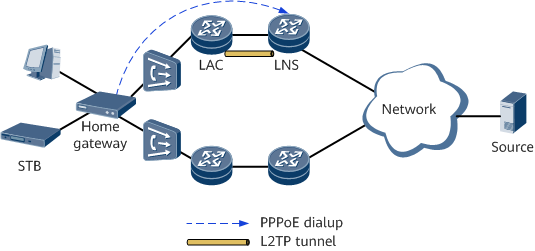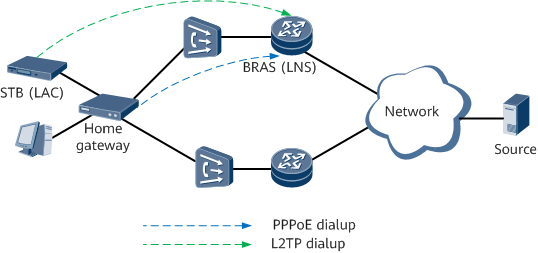IGMP over L2TP
Background
On the live network, the OTT service mode uses unicast technologies rather than multicast technologies. As such, this mode provides only delayed live broadcast services. Applying this mode to the programs that have high requirements on real-time performance, such as galas and sport events, will cause poor user experience and consume a large amount of bandwidth. The IPTV mode, which uses multicast technologies for transport, can provide real-time live broadcast services with low bandwidth consumption. Therefore, carriers urgently need an upgrade from the OTT mode to the IPTV mode. One of the key prerequisites for such an upgrade is configuring the IGMP over L2TP function for the BRAS.
Implementation
Carriers can perform an upgrade from the OTT mode to the IPTV mode on the live network using either of the following methods:
- Deploy a standalone LAC on the network, and configure the home gateway to use PPPoE to dial up to the LNS.
- Configure the STB to function as a LAC and dial up to the LNS, and configure the home gateway to use PPPoE to dial up to the BRAS (the LNS and BRAS can be deployed on the same device).
Method 1
Figure 1 shows the networking where a standalone LAC is deployed and the home gateway uses PPPoE to dial up to the LNS. The service process is as follows:
- An L2TP tunnel is established between the LAC and LNS.
- The home gateway dials up to the LNS through PPPoE to obtain an IP address.
- The STB user orders a program by sending an IGMP Report message to the home gateway.
- The home gateway converts the received IGMP Report message into a PPPoE packet by encapsulating it with a PPPoE header and sends the PPPoE packet to the LAC.
- The LAC decapsulates the PPPoE packet, converts it into an L2TP packet by encapsulating it with an L2TP header, and sends the L2TP packet to the LNS.
- The LNS decapsulates the L2TP packet and authenticates the ordered multicast program. If the authentication succeeds, the LNS generates a multicast routing entry for traffic diversion. In addition, the LNS periodically sends IGMP Query messages to check whether the program is still required.
- When the user no longer watches the video program, the STB sends an IGMP Leave message. After receiving the message, the LNS deletes the program authentication result as well as the multicast routing entry.
- After detecting the logout of the user, the LNS deletes its information.

Method 2
Figure 2 shows the networking where the STB functions as a LAC and dials up to the BRAS (LNS) and the home gateway uses PPPoE to dial up to the BRAS (LNS). The service process is as follows:
- The user performs PPPoE dialup through the home gateway to obtain an IP address from the BRAS (LNS). The STB obtains a private network IP address from the home gateway through DHCP.
- The STB performs L2TP dialup and establishes an L2TP tunnel with the BRAS (LNS). The BRAS (LNS) authenticates the STB and assigns an IP address to the STB.
- The STB user orders a program by sending an IGMP Report message. The message is then encapsulated with an outer PPPoE header and an inner L2TP header and sent to the BRAS (LNS).
- The BRAS (LNS) decapsulates the PPPoE packet and authenticates the ordered multicast program. If the authentication succeeds, the BRAS (LNS) generates a multicast routing entry for traffic diversion. In addition, the BRAS (LNS) periodically sends IGMP Query messages to check whether the program is still required.
- When the user no longer watches the video program, the STB sends an IGMP Leave message. After receiving the message, the BRAS (LNS) deletes the program authentication result as well as the multicast routing entry.
- After detecting the logout of the user, the BRAS (LNS) deletes its information.

The BRAS and LNS can also be separately deployed.
